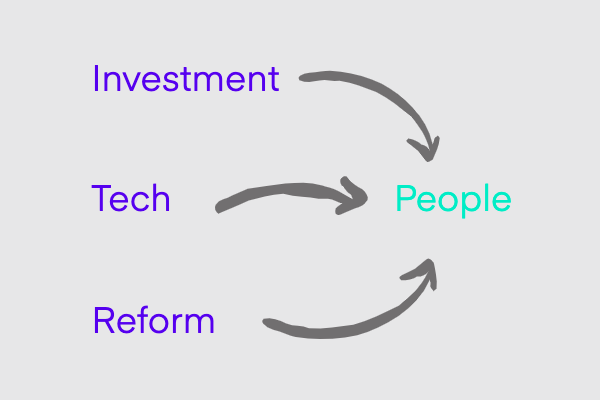The home care sector needs more people to join the workforce and meet rising demand for care.
Technology, funding and reform must also combine to find a way of decreasing pressure on the existing home care workforce.
With around 70,000 job vacancies and the Health and Social Care Committee enquiry into ‘Workforce burnout and resilience in the NHS and social care’ calling for a new workforce strategy, the home care workforce continues to be challenged to attract, retain, and grow capacity to meet demand.
Leaders representing social care charities and associations have written to the Prime Minister, Chancellor of the Exchequer and the Secretary of State for Health and Social Care, urging them to publish the government’s proposals for social care.
Meanwhile, speaking at the Future of Care Conference in June, CEO of Care England Professor Martin Green said he did not expect the government to deliver a new vision for social care, and urged care providers to take matters into their own hands, adding that people should be given a life, not a set of services.
The Covid-19 pandemic has forced care professionals to work harder and harder; a combination of sickness, self-isolation and, sadly, deaths, has impacted on workforce capacity and increased the workload on care professionals operating at the front line of care delivery.
From 9 Mar to 28 Dec 2020 care workers and home carers accounted for most deaths involving COVID-19 among men and women working in health and social care: 347 out of 469 deaths. ONS
The care workforce is under immense strain and the demand for home care is increasing. There is significant pressure on the government to reform the care sector.
How much investment could reform the care sector?
The London School of Economics and The Lancet formed the LSE-Lancet Commission to put forward their analysis of the investment required to reform health and social care.
For social care, the Commission suggests injecting £3.2bn to increase the number of people who would then qualify to receive state funded care.
However, this positive recommendation does not directly address the capacity challenge required to provide care; to reform home care, the workforce needs appropriate and effective stimuli to grow.
In its broader recommendations for health and social care, the LSE-Lancet Commission urges government to increase funding by £102bn to allow the NHS, social care, and public health to meet future demand.
Part of this funding increase is to keep pay in line with average earnings. Improving pay could help the social care workforce to attract and retain more people.
Care work is skilled and challenging, and people working in care deserve to be paid at a rate that recognises their value to society.
“People are at the heart of our care sector. Care staff want to be able to focus their time on caring for those they look after, and technology can help make that happen.”
Helen Whately, Minister of State for Social Care
However, pay is not the only aspect of a solution required to increase the capacity of the home care workforce.
Technology needs to do more, to help ensure accurate pay, and support the workforce in every aspect possible to make care a respected and enjoyable profession.
The Health and Social Care Committee recommends that a new ‘workforce strategy should also prioritise the health, morale, and well-being of its workforce to maximise the recruitment and retention of staff.’
It added that technology should be at the centre of this strategy and that ‘home care technology could improve care planning, service delivery and personalisation’.
Technology needs to move forward and provide significant support to the home care workforce
There are a number of technology solutions available for home care providers that digitise workflows previously recorded on paper, word processor or spreadsheet software.
This is helpful because the information is stored in one place, updated regularly and can be retrieved.
In an era of reform, care professionals now need advanced technology that ‘works’ for them, quickly solving complex tasks, such as organising an entire schedule in seconds, saving huge amounts of time, cost and stress.
MyHelpa’s advanced AI-driven scheduling tool is designed to give care professionals, no matter what the size of the team, the capability to organise and reorganise their visits in seconds.
Through the carer app, MyHelpa provides care professionals with transparency and control over their availability.
The platform also records contact, travel and waiting time, while the optimisation of travel routes ensures care professionals take home the highest amount of pay and helps ensure visits are not late, missed or cancelled.
To develop and grow care teams, remove ambiguity, frustration and worry and provide transparency, assurance and engagement
Care professionals are critical to the care system. That is why we are moving home care technology forward, creating advanced scheduling capabilities for care teams to thrive.
Working in care is hard work, and technology can be harnessed to support and augment care professionals.
Technology can’t (and shouldn’t) replace hands-on care, but it can automate workflows and create seamless, transparent communication pathways. It can help home care providers to grow.
While we wait for the government to publish its proposals for social care, there is technology available now that can help engage, retain, and grow the care workforce, while providing continuity of care to the people and families whose lives rely on home care.
Alex Cavell, CCO & Co-Founder of MyHelpa
Want to stay up to date with MyHelpa? Sign up to our updates here
Join us on LinkedIn
If you want to talk about MyHelpa and learn more about how it can help you, or if you want to use MyHelpa’s scheduling tool to see the platform first hand, or share your views on what you need from your software, please get in touch by email at hello@myhelpa.com

